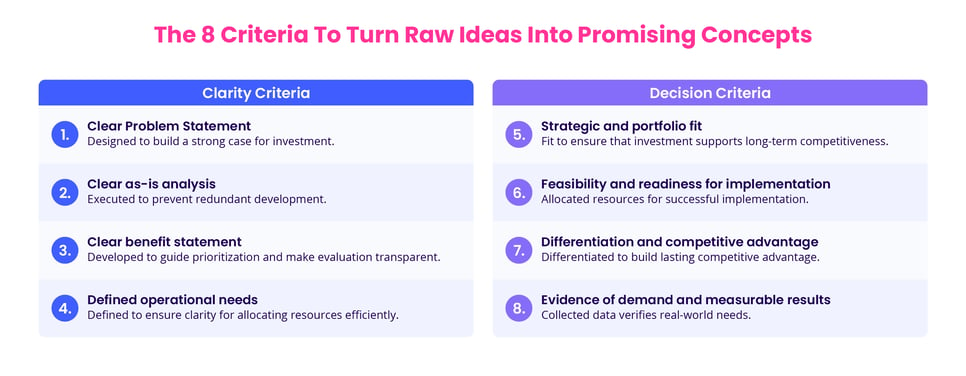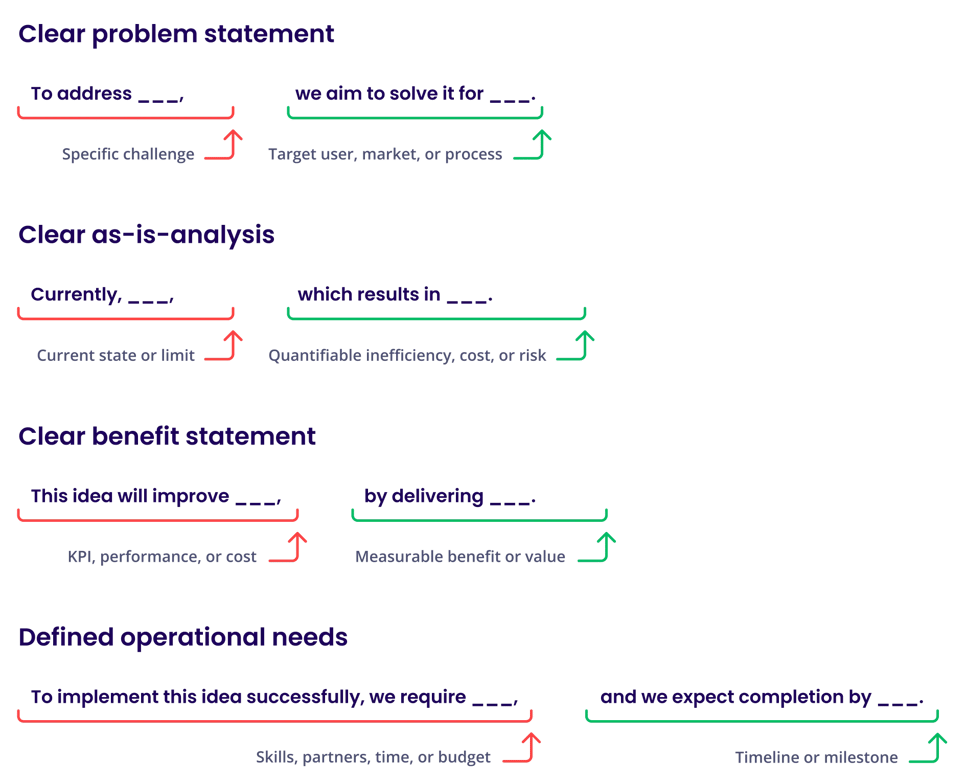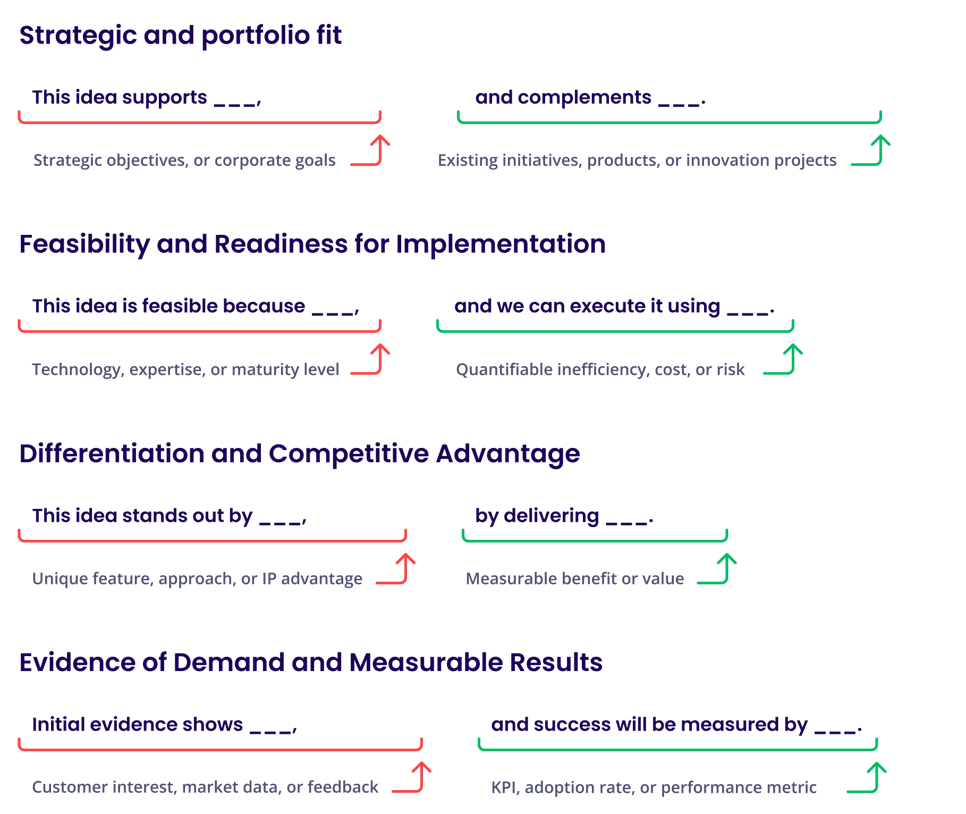Innovation starts with ideas. But only structured idea development turns them into results - repeatedly. Many organizations collect hundreds of ideas but fail to identify which ones are truly worth pursuing. Without clarity, process, and shared criteria, even the most creative organizations risk wasting time on noise instead of nurturing concepts that drive measurable value.
The key insight of this article is that good idea formulation increases the ideation success rate. The better they are formulated, the higher the chance of funding.
Overall, the best idea descriptions share clear problem statements, defined benefits, and realistic implementation planning. Companies that apply transparent evaluation processes outperform those that rely on intuition alone. Companies with structured evaluation cycles can focus resources on ideas that are strategically aligned, needed by customers, and technically feasible.

Exhibit 1: The 8 criteria for idea development
Idea management brings order to creativity. When teams follow a consistent innovation process, they can evaluate ideas objectively, avoid duplication, and strengthen decision-making.
Clarity in submissions through structured templates or idea statements enables faster assessment, better collaboration, and a common language across functions. This structure transforms raw input into a reliable innovation pipeline rather than a collection of untested proposals.
Our experience shows us that eight criteria distinguish great ideas from good ones, divided into two stages (Exhibit 1):
-
Clarity criteria: a clear problem statement, as-is analysis, benefit statement, and defined operational needs
-
Decision criteria: strategic fit, feasibility, differentiation, and evidence of demand
Together, these principles help teams evaluate ideas consistently and build innovation portfolios that align with business goals.
Why clear ideas are critical for innovation management success
Idea management fails when submissions lack clarity: without a clear description, evaluators spend time interpreting instead of assessing. Structured idea management transforms creativity into measurable input for decision making.
Clarity in idea submissions is essential for ensuring alignment with strategic goals, as it connects new initiatives to the overall product strategy and team capacity. Well-defined processes help maintain consistency and transparency in idea evaluation.
In modern innovation management systems, clarity reduces friction. Precise definitions enable faster evaluation, transparent scoring, and better alignment with business strategy. When ideas move through a consistent process, the organization learns faster, reduces bias, and accelerates digital transformation across teams.
What distinguishes a good idea from a great one?
In idea development, quantity is never the problem, but quality is.
A good idea solves a problem. A great idea changes the way a problem is defined. Innovation goes far beyond brainstorming: it's about evaluating contexts, feasibility, and long-term value. Idea submitters should consider this thought of line and move from "That's my brilliant idea." to "That's why my idea is brilliant.".
Innovative ideas often begin as creative concepts, which are then refined through careful analysis and multiple iterations. Organizations should focus on identifying and nurturing innovative ideas that have the potential to drive significant change.
Benefits of clear idea descriptions for evaluating ideas effectively
Evaluating ideas requires shared language. Detailed, well-structured descriptions reveal feasibility, potential impact, and competitive advantage. They allow R&D and product teams to compare alternatives objectively rather than subjectively. Clear descriptions also help teams identify the most impactful ideas for further development and investment.
Tools like the idea statement template break ideas into opportunity, proposed solution, and product or approach. The template helps to standardize how ideas are expressed. This structure promotes clarity and consistency, making it easier to recognize valuable ideas early in the innovation process.
With the help of this tool, both categories - clarity criteria (Exhibit 2) and decision criteria (Exhibit 3) can be served:

Exhibit 2: The idea statement template for clarity criteria

Exhibit 3: The idea statement template for decision criteria
Clarity also strengthens data-driven decision-making. A strong idea description supports analytics in idea management software, enabling pattern recognition across projects. Following key steps in the evaluation process ensures that no promising or valuable ideas are overlooked. Over time, this creates institutional memory as insights make future evaluations faster and smarter.
Common mistakes in idea generation and early idea collection
Most organizations collect too many ideas and develop too few. Unfiltered idea generation produces duplication, confusion, and resource waste. And in the end, the best ideas drown in a large volume.
A systematic approach to gathering ideas from diverse sources, such as customers, team members, and internal campaigns, ensures that valuable input and inspiration are captured to inform innovation.
Another common mistake is skipping context. Teams often describe solutions without defining the underlying problem. Early idea collection should capture both the challenge and the expected benefit.
Finally, many companies treat idea management as an administrative task instead of a strategic process. Structured evaluation and disciplined follow-up turn creative input into innovation outcomes. Without a structured evaluation process, organizations risk missing opportunities for growth and struggle to remain competitive in rapidly changing markets.
The 8 criteria met by the best ideas
Not every idea deserves funding. The best ideas meet a clear set of criteria that make them feasible, valuable, and aligned with strategic focus.
The following eight criteria help teams determine which ideas are worth pursuing, ensuring that only those with the greatest potential and strongest strategic focus move forward. Organizations must also prioritize ideas based on their alignment with strategy and potential impact. These criteria streamline idea management and ensure that innovation projects create measurable outcomes with real value.
A disciplined idea management process turns creativity into repeatable performance. Each idea is evaluated consistently, linking creative input to business priorities and available resources. And applied correctly, the innovation process becomes a reliable decision-making system, not a guessing game.
Clarity criteria that ease understanding
Clarity is the foundation of idea development. Even strong ideas fail if they’re lost in translation across teams. A structured process ensures every idea is described and evaluated with the same logic.
Clear criteria don’t limit creativity; they make it actionable, speeding up evaluation and learning across the organization.
1. Clear problem statement
A great idea begins with a precisely defined problem. Teams must identify who experiences the problem, why it matters, and what current solutions fail to address. This critical step aligns innovation efforts with real customer needs and avoids misdirected projects.
A clear problem statement builds a strong investment case and helps evaluators link ideas to strategic objectives.
2. Clear as-is analysis
Understanding the current state reveals the gap that an idea must close. An as-is analysis defines the baseline: technical, operational, or experiential. It allows teams to evaluate feasibility early and use existing resources more effectively.
In innovation management, this discipline prevents redundant development and highlights where real differentiation can emerge.
3. Clear benefit statement
An idea’s value must be explicit. Teams should describe measurable improvements: cost, performance, sustainability, or customer impact. Clear benefits guide prioritization and make evaluation transparent.
4. Defined operational needs
Even the best ideas fail without realistic implementation planning. Listing operational needs, like skills, partners, time, and budget, translates concepts into action.
This clarity ensures that R&D and innovation teams allocate resources efficiently, aligning with both strategic goals and digital transformation priorities.
Decision criteria that identify the best ideas
Idea development is only valuable if it leads to strong, evidence-based decisions. Identifying the best ideas requires objective evaluation, not intuition. Clear criteria transform creativity into a structured process that connects ideas to real business value. The product manager's role is crucial in prioritizing and communicating about new ideas within the organization.
5. Strategic and portfolio fit
Ideas must align with strategic objectives and existing innovation projects. An idea that fits the portfolio strengthens coherence and maximizes shared resources. Alignment ensures R&D investment supports long-term competitiveness, not distraction.
6. Feasibility and readiness for implementation
Even the best ideas fail without technical and organizational readiness. Assess technical feasibility, available resources, technology maturity, and time-to-deploy early. Feasibility analysis turns abstract potential into realistic development planning.
Effective resource allocation is essential for successful implementation, ensuring that resources are distributed to maximize benefits and strategic goals. The product manager plays a key role in evaluating and guiding ideas through the process, overseeing prioritization and ensuring alignment with organizational capabilities.
7. Differentiation and competitive advantage
A promising idea stands out for its uniqueness and defensibility. Evaluate how it improves performance, cost, or user experience compared to current solutions. Clear differentiation builds a lasting competitive advantage and protects innovation efforts from imitation.
8. Evidence of demand and measurable results
Great ideas solve real problems that customers care about. Collect early data, like user feedback, market signals, prototype results, or market demands, to verify that ideas meet real-world needs. Define measurable outcomes upfront to evaluate innovation success and guide future innovation decisions.
Integrating clear idea development guidelines into the idea management process
Clear idea development guidelines turn innovation from a collection of inputs into a managed process that produces results. When teams know how to describe, evaluate, and advance ideas, decision-making becomes faster and less biased. Integrating these guidelines into the idea management process ensures every idea follows the same transparent path: from submission to evaluation to implementation.
Embedding structure in every stage of idea management
Organizations that systematize their idea management processes see higher throughput and better-quality outcomes: configurable templates, structured workflows, and defined evaluation criteria standardize how ideas are captured and compared.
Rather than relying on ad hoc submissions or scattered spreadsheets, a structured process ensures that every idea meets basic clarity standards - problem, benefit, feasibility, and expected impact - before it enters formal evaluation. This reduces administrative friction, prevents duplication, and enables teams to focus on what truly drives innovation performance.
Guiding submitters with clarity and consistency
The first step toward scalable innovation is helping submitters formulate better ideas. Clear guidance about what information to include, what evidence to provide, and how to connect to strategic goals reduces rework and accelerates review cycles.
By embedding evaluation logic directly into the submission process, organizations can ensure every idea aligns with business priorities from the outset. Structured feedback loops then enable continuous improvement, helping contributors refine ideas rather than abandon them.
How ITONICS enables structured idea development for a lasting competitive advantage
The ITONICS Innovation OS makes structured idea development simple, consistent, and configurable.
Teams can create customizable idea templates that recommend contributors (Exhibit 4) to define the problem, benefits, and feasibility upfront. If anyone in the organization doesn't know the expert for any topic or any idea submitted, the system can identify duplicates and suggest the right experts for validation./Still%20images/ideation-involve-recommended-experts-2025.webp?width=2160&height=1350&name=ideation-involve-recommended-experts-2025.webp)
Exhibit 4: Involving recommended experts within ITONICS
Configurable evaluation criteria (Exhibit 5) allow decision makers to assess ideas based on weighted factors like strategic fit, technical feasibility, and market potential.
When everything is a priority, nothing moves forward. Therefore, fair priorities need to be set. To facilitate the process, standardized evaluation frameworks and collaborative team input need to be joined, that the right ideas get the green light.
/Still%20images/ideation-evaluate-collaboratively-2025.webp?width=2160&height=1350&name=ideation-evaluate-collaboratively-2025.webp)
Exhibit 5: Evaluation frameworks for collaborative input in ITONICS
Campaign pages (Exhibit 6) guide submitters through tailored challenges and innovation focus areas, keeping idea collection aligned with portfolio and business strategy.
The pages further allow building submission forms, campaigns, or full HTML sites directly within ITONICS. Thus, the experience for the target audience can be fully customized, and each organization, on the other hand, can define who can assess the page - even outside ITONICS.
/Still%20images/Ideation%20Mockups%202025/ideation-build-engaging-campaign-pages.webp?width=2160&height=1350&name=ideation-build-engaging-campaign-pages.webp)
Exhibit 6: Building engaging campaign pages within ITONICS
Together, these capabilities transform idea management into a transparent, data-driven process that scales across teams and geographies. With ITONICS, organizations move beyond collecting ideas: they build a repeatable system for developing, evaluating, and prioritizing the concepts that matter most.
FAQs on the 8 idea development criteria
Why is idea management important for innovation?
Idea management provides structure to creativity. It ensures that ideas are captured, evaluated, and developed through a transparent, repeatable process. This discipline helps organizations identify the most promising ideas, allocate resources effectively, and connect innovation activities directly to strategic priorities.
How do you evaluate ideas objectively?
Objective evaluation relies on defined criteria such as problem clarity, feasibility, differentiation, and measurable benefits. By applying consistent scoring methods, teams eliminate bias and ensure fair comparison across ideas. This structured approach turns creative input into evidence-based innovation decisions that drive measurable outcomes.
What role does idea management software play in structured development?
Modern idea management software embeds structure at every stage of innovation. It allows organizations to configure idea templates, evaluation criteria, and campaign pages that guide submitters from concept to clarity. By centralizing collaboration and decision making, it transforms idea management from a manual task into a scalable innovation process.
How can structured idea development scale innovation success?
When organizations standardize how ideas are described, assessed, and advanced, they accelerate learning and decision making. Configurable software systems like ITONICS make this possible by embedding clarity into every submission and feedback cycle. This repeatable structure helps organizations scale innovation systematically while maintaining strategic focus.




